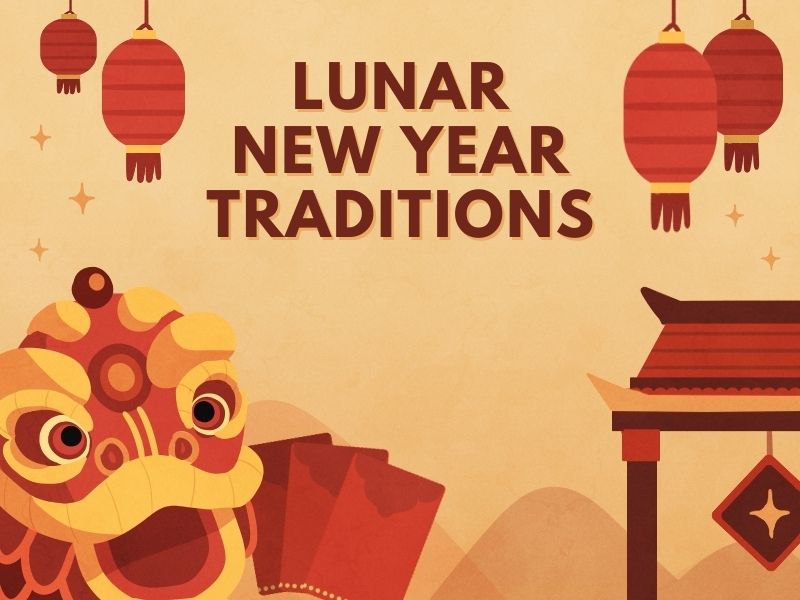
By Jessica Nguyen & Brian Pham
Lunar New Year is an Asian holiday that celebrates the start of a new year according to the lunar calendar. Taking place usually at the beginning of February, it is a festive time for families to come together and honor ancestors, households and deities. Lunar New Year takes place on Feb. 12 this year and comes with many customs, such as lion dancing, red envelopes and Chinese zodiacs, so what are the origins of these traditions?
Lion dancing
Gold and red lions can be found parading through the streets, accompanied by the loud pounding of drums and cymbals, during Lunar New Years. Underneath the lion costume, lion dancers, usually two, move like a pantomime horse with one person acting as the front and head and the other as the back.
Although there are many stories about how lion dancing came to be, many people date it back to the Chinese Tang Dynasty after an emperor had a dream where a lion saved his life. From then, the lion became a symbol of wisdom and power, and the dance to celebrate it became popular in courts and later festivals. It is thought to bring good luck during Lunar New Year and ward off evil spirits.
From China, the lion dance spread to other parts of Asia and developed into southern and northern styles.
Although they both consist of the lion costume, the southern lion dance emphasizes the lion’s behavior, creating vivid and comical performances in which the lion will shake its body and even play with a ball.
On the other hand, the northern lion dance is similar to kung fu that focuses more on gymnastics. With less decorative costumes, the dance has more jumping, wrestling and climbing moves.
Red envelopes
For Asian youth, Lunar New Year is one of the most anticipated times of the year because of the lucky red envelopes filled with new money. Red envelopes are a tradition in which they are handed from typically older members of the family to children or other family members. The importance of the envelopes lies in the envelope itself, which is bright red, a symbol of good luck and happiness in Asian cultures.
Red envelopes are one of the oldest traditions. It comes from a story about Sui, a demon who would terrorize children on Lunar New Year Eve. Parents would try to keep their children awake in order to protect them from Sui. One night, a boy was given eight coins to play with but still fell asleep. When Sui arrived, ready to terrorize the boy, the coins, which were actually the Eight Immortals disguised, warded the demon away. Because of this, the lucky red envelope reminds people of the coins and the legend of Sui.
Chinese Zodiac
The Chinese Zodiac consists of 12 animals: the rat, ox, tiger, rabbit, dragon, snake, horse, goat, monkey, rooster, dog and pig.
Similar to the western zodiac, the zodiac sign of a person is attached to personality traits. An example would be how people who have the rooster zodiac sign are commonly seen as intelligent. While the western zodiac rotates by months, the Chinese zodiac rotates by years. The zodiac for 2021 is the ox.
There are several legends about the Chinese Zodiac and how it came to be but the most common one depicts a race between the zodiac animals. The legend states that the Jade Emperor invited all of the animals to participate, but only the first twelve who arrived were allowed to become a zodiac. They were ranked by the order they came; the rat came first, followed by the ox and so on.
Some may ask why the rat and the dog are included in the Chinese Zodiac but not the cat. The legend states that on the day before the race, the cat asked the rat to wake it up for the race. In some stories, the rat forgot, and in others, the rat didn’t wake up the cat on purpose so the cat slept through the race and did not become part of the zodiac.
Interestingly, the Vietnamese Zodiac, which is very similar to the Chinese Zodiac, only has one difference. In the place of the rabbit, the cat stands in the zodiac. This is likely due to a translation error as the word for cat sounds similar in Chinese and Vietnamese.
While Lunar New Year in the United States is going to look very different from previous years due to COVID-19 guidelines on gatherings, that doesn’t mean that these traditions are going to be gone. There are still plenty of ways to celebrate them, such as digital red envelopes and having fireworks in your own backyard!
Whether you celebrate Lunar New Year or not, it is always important to learn about other cultures and traditions, especially with the diverse environment of Fountain Valley High School. Stay safe, Barons and we’ll see you in the year of the ox!





